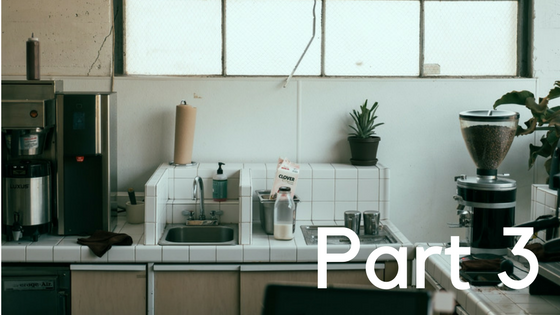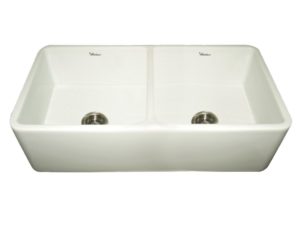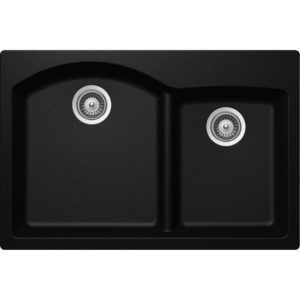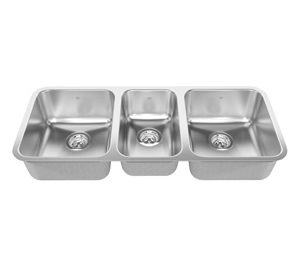Read Part 1 of this series
Read Part 2 of this series
How many basins do you need?
Sink selection doesn’t stop at the selection of the material alone, you must also determine how many basins you would like. It’s possible to fit two basins into the same size as a single large one, so size doesn’t necessarily dictate basin count. The two main deciding factors for sink size are #1) what size the base cabinet is and #2) how much countertop space do you want to use up.
Single basin sinks
Large deep single basin sinks are currently very popular and trendy. They can lend a contemporary look to a kitchen with straight-cornered stainless steel, or a more traditional look with a porcelain farmhouse style. Sink accessories (cutting boards, racks and rinse baskets) will go a long way to help overcome the limitations of one basin.
Pros:
- Wide range of sizes (make sure to have an appropriate sized base cabinet)
- Large deep ones will easily manage to soak or wash large pots and trays or prep large quantities/sizes of food
- Smaller sizes can be real space savers and maximize counter space
- Wide range in styles to suite different decors
- Choice of faucet placement (back, side or corner)
- Can be less expensive to purchase and install
- May fit smaller base cabinets more readily
Cons:
- You’ll need a drying area to one side of the sink which takes up countertop space
- Rinsing immediately after washing requires some forethought. In other-words, don’t fill your sink up too much initially because each time you rinse an item the sink fills up a bit more with water. Read here what the Brits do to overcome single basins
- Not as versatile as double basins when multi-tasking
Two basins of the same size
This configuration is what many people are comfortable with and happy using. They offer versatility without compromising performance.
Pros:
- Either side can be used comfortably for prepping, rinsing, washing, or drying in (which frees up countertop space)
- May use less water than large single basins
- Available in contemporary, traditional or transitional styles
- Many people prefer the symmetry of same-sized basins
Cons:
- Can be harder to fit into smaller kitchens (make sure to have an appropriate sized base cabinet)
- Limited faucet installation option as it needs to reach both basins
- Can be more expensive to purchase and install than single basins
Two basins of different sizes
Great for people who want versatility but don’t have the space for two same-sized basins. These sinks are offered in configurations where one basin is smaller in width and sometimes depth, than the other. Miss M has used one of these in the small kitchens of Switzerland for years, and they work better than you think.
Pros:
- Useful for preparing food and cleaning dishes simultaneously
- May use less water and detergent
- The smaller of the two basins can be useful for cleaning veggies, rinsing your dishes, a garbage disposal, and pouring dirty water down
- The smaller sink is often available in a choice of at least two widths
Cons:
- Limited faucet installation option as it needs to reach both basins
- Can be more expensive to purchase and install than a single basin
- More difficult to wash larger pots in, and the smallest of the two basins can be even trickier to rinse large pots in. TIP: This is where a pull-out nozzle comes in very handy!
Three basins of different sizes
Generally they are available with two same-sized sinks and a central smaller one. There isn’t a large choice from manufacturers but if you love to cook, have a large kitchen, or use a garburator these can be a useful addition. TIP: The smallest basin would accommodate the garburator.
Continued in Part 4….





